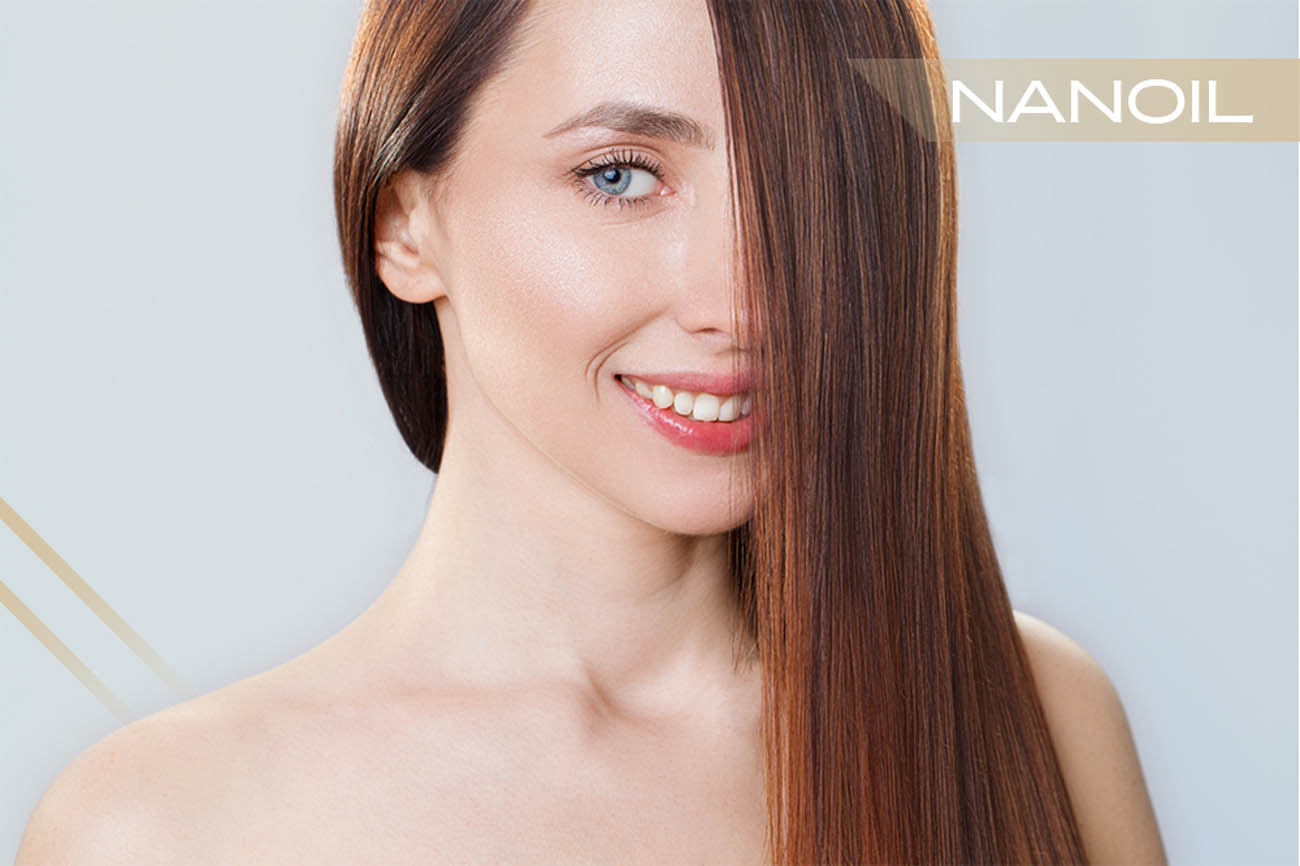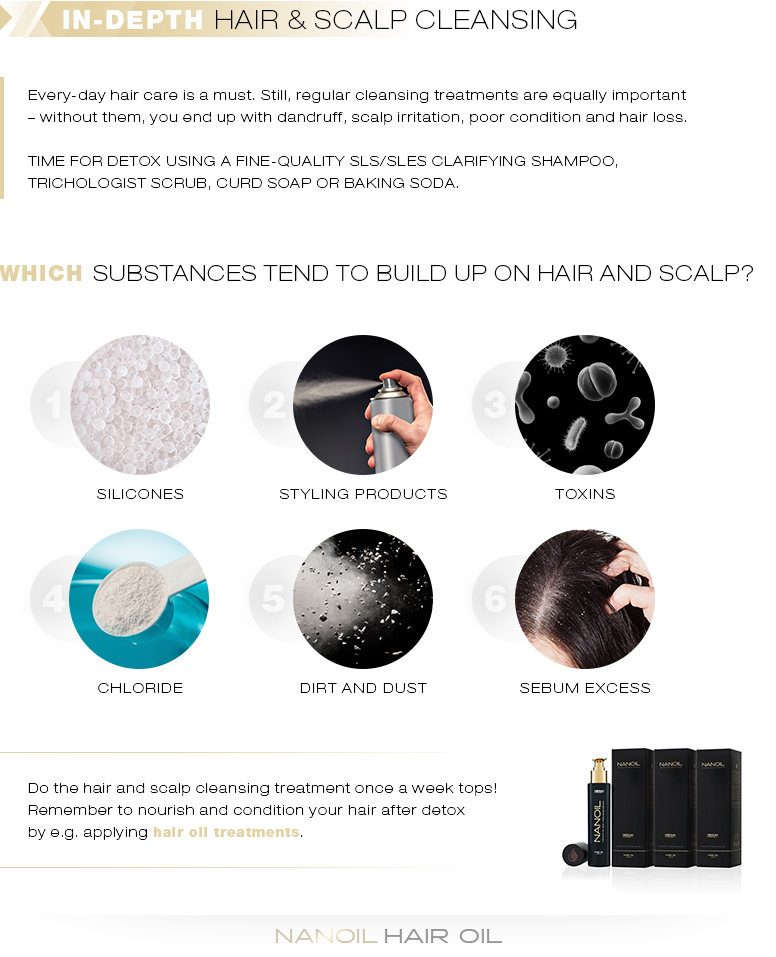- NANOIL Products
- Oils
- Face serums
- Hair masks
- Shampoos
- Hair conditioners
- Hair styling
- Hair Porosity Test
- Blog
- Contact

You don’t think your hair needs strong cleansing? If you apply masks, conditioners and oils every day, your hair must be crying for detox. Find out how to deeply purify your scalp and hair.
Hair care is complicated – you can’t go to extremes. If you fail to deliver necessary nutrients, your hair loses vitality and shine. On the other hand, exaggerated hair care does harm as well. Finding the golden mean is a must. A regular hair detox – an in-depth scalp and hair purification – comes to the rescue.
There are lots of hair weakening elements, ranging from wrong hair care or lack of it to using improper products. Too much care and over-conditioning harms your hair, too.
Even thick, dense hair gets weaker due to too much styling products or overusing masks and conditioners, let alone cosmetics filled up with resistant film-forming substances such as silicones. It’s hard to get them out of hair, especially when you limit yourself to mild shampoos. How to fix that? It is high time you got down to in-depth hair cleansing.
Scalp detox is an extremely important element of trichotherapy. It has been proven that impurities (including dust, dirt, styling primers, mask’s ingredients, even oils) settling on hair and clogging the outlets of sebum glands have a detrimental impact on the appearance and health of hair. Without regular cleansing, your hair:
Regular hair and scalp cleansing treatments hugely matter. You should provide hair with detox no matter how often you wash it. If you use mild SLS-free shampoos, the cleansing effect is very gentle and superficial. Substances which cling to hair most strongly stay and build up on hair, forming a destructive layer. We can cleanse hair only by using a strongly clarifying shampoo or a trichologist scrub.
There are two options to choose from:
The first option is definitely cheaper and easier to perform. Having a salon treatment done is much pricier and time-consuming as it requires regular appointments.
At least once a week. If your scalp and hair are very delicate, you shouldn’t do cleansing treatments more often than every ten days.
One of the most important rules in hair care says that a regular use of SLS and SLES shampoos destroys hair. It’s true because these strong detergents leave hair extremely dry. However, considering the must-do detox from time to time, they work wonders and you shouldn’t rule them out in your hair care. The so-called aggressive shampoos are made for regular and deep cleansing every (other) week.

Hair and scalp cleansing requires suitable products which let us easily get rid of toxins, silicones, mineral oils, etc. If you’re planning on detox, reach out for:
As in most cases, even removing silicones from hair can be done without the use of ready-made cosmetics. Apart from the oil and brown sugar or sea salt scalp scrub you can make at home, there are a few more DIY remedies for hair and scalp, keeping them clean.
Which home hair & scalp-cleansing methods are worth testing?
It is an extremely popular method which lets you easily and naturally cleanse your scalp. Mix a tablespoon of baking soda with a few tablespoons of water (the pulp should have a conditioner’s consistency), apply it to hair and scalp, rinse out using lukewarm water after a few minutes. There’s more to it, though!
You should definitely combine baking soda cleansing with another routine – rinsing hair with an acidic mixture. Baking soda deprives hair of its natural protection totally. Hair has open cuticles thus it’s coarse, loses moisture and nutrients. All you need to do is try an apple cider vinegar rinse which closes and smoothes the cuticles. Moreover, vinegar has extra cleansing properties and restores pH balance to your scalp.
Washing hair with a cosmetic clay is another alternative to shampoos. This simple, natural ingredient has amazing purifying effect – it attracts all impurities and toxins, which makes it a splendid hair and scalp detoxifier. Applying clay to hair in form of a mask, scrub or an additive to a mild shampoo lets you purify and disinfect your scalp, as well as regulate the working of sebum glands. You don’t need to make a clarifying treatment yourself, though. Now, you can choose between pure cosmetic clay and a readymade super-cleansing charcoal and white clay hair mask from Nanoil.
Herbs have brilliant cleansing effect as well. Use them for making purifying hair rinses. Even though their cleansing power isn’t as strong as the SLS shampoos’, they can enhance your hair and scalp detox treatments. Green tea, nettle, thyme, camomile, rosemary and sage have purifying and conditioning qualities. All you need to do is use a herbal rinse for final rinsing after every hair wash. You’ll see the difference after just a few weeks.
Key thing! An in-depth hair and scalp cleansing deprives us of both impurities and (sadly) the natural hydro lipid coat which protects against harmful elements and prevents the loss of water.
Therefore, after using a clarifying shampoo, trichologist scrub or other hair and scalp detox techniques – nourishing your hair is a must. You can do it in a few ways. A conditioner seems to be the easiest way but it gives a superficial effect. Doing a hair oil treatment at home works far better, nourishing, smoothing and protecting hair, as well as rebuilding the natural hydro-lipid barrier.
After hair and scalp detox, use a natural oil. Applying a blend of oils such as Nanoil makes a good solution, delivering all your hair needs to keep healthy and stunning.
Leave your email address and we ll notify you when the product is back in stock.
Comments: #0